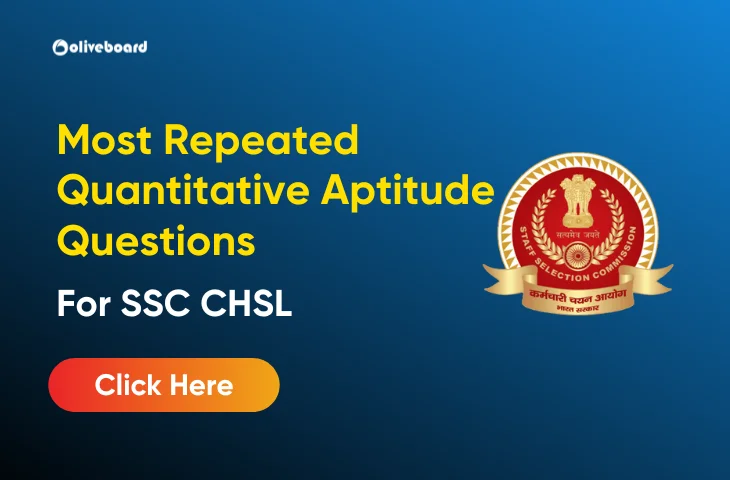The Quantitative Aptitude section in SSC CHSL Tier 1 is one of the scoring sections if approached strategically. It tests your mathematical skills, problem-solving ability, and speed. Practicing most repeated and high-difficulty questions can help you understand patterns, save time during the exam, and maximize your score. To cover all important questions in detail, you can download the complete set of 100 Quantitative Aptitude Questions PDF for thorough practice.
Download 100 Most Repeated Quantitative Aptitude Questions PDF for SSC CHSL
To access all 100 most repeated Quantitative Aptitude questions for SSC CHSL, download the PDF below. This PDF includes high-difficulty level questions with detailed solutions and explanations for complete preparation.
Most Repeated Quantitative Aptitude Questions for SSC CHSL
Here are some Most Repeated Quantitative Aptitude Questions for SSC CHSL Exam that are often repeated:
1. If x + y = 10 and x² + y² = 58, find xy
a)12
b)16
c)18
d)20
Answer: b)16
2. A train 180 m long passes a platform in 12 seconds. If the speed of the train is 54 km/h, find the length of the platform.
a) 120 m
b) 150 m
c) 180 m
d) 210 m
Answer: b) 150 m
3. The sum of three consecutive odd numbers is 75. Find the numbers.
a) 23, 25, 27
b) 25, 27, 29
c) 21, 23, 25
d) 27, 29, 31
Answer: b) 25, 27, 29
4. A man can row 20 km downstream in 2 hours and the same distance upstream in 4 hours. Find the speed of the stream.
a) 2 km/h
b) 3 km/h
c) 4 km/h
d) 5 km/h
Answer: a) 2 km/h
5. Solve the quadratic equation: x2−5x+6=0x^2 – 5x + 6 = 0x2−5x+6=0
a) x = 2, 3
b) x = -2, -3
c) x = 1, 6
d) x = 3, 4
Answer: a) x = 2, 3
6. If the sum of the first n natural numbers is 210, find n.
a) 20
b) 19
c) 21
d) 22
Answer: c) 20
7. A and B can do a piece of work in 12 days together. B alone can do it in 20 days. In how many days A alone can complete the work?
a) 30 days
b) 24 days
c) 20 days
d) 18 days
Answer: b) 24 days
8. If sin A = 3/5, find cos A.
a) 4/5
b) 5/4
c) 3/4
d) 4/3
Answer: a) 4/5
9. A sum of Rs. 12000 is lent at simple interest. If the rate of interest is 8% per annum, find the interest after 2.5 years.
a) Rs. 2400
b) Rs. 2600
c) Rs. 2500
d) Rs. 2700
Answer: c) Rs. 2400
10. Find the probability of getting a sum of 8 when two dice are rolled.
a) 5/36
b) 7/36
c) 1/6
d) 1/8
Answer: a) 5/36
11. If x = 2 + √3, find the value of x² + 1/x²
a)14
b)10
c)7
d)13
Answer: b)10
12. The ratio of the ages of A and B is 4:5. After 5 years, the ratio becomes 5:6. Find the present age of A.
a)15 years
b)20 years
c)25 years
d)30 years
Answer: b)20 years
13. A man bought an article at 20% discount on the marked price and sold it for ₹1200, making a profit of 25% on the cost price. Find the marked price.
a)₹1200
b)₹1250
c)₹1500
d)₹1600
Answer: d)₹1600
14. The simple interest on a sum for 5 years is one-fourth of the principal. Find the rate of interest per annum.
a)4%
b)5%
c)6%
d)8%
Answer: b)5%
15. The average of 5 consecutive even numbers is 38. Find the smallest number.
a)30
b)32
c)34
d)36
Answer: d)36
16. The perimeter of a rectangle is 84 cm and its breadth is 16 cm. Find its area.
a)560 cm²
b)512 cm²
c)480 cm²
d)420 cm²
Answer: a)560 cm²
17. A man travels 30 km at a speed of 40 km/h and the next 30 km at a speed of 60 km/h. Find his average speed for the entire journey.
a)45 km/h
b)48 km/h
c)50 km/h
d)52 km/h
Answer: b)48 km/h
18. The population of a town increases by 10% in the first year and decreases by 10% in the second year. What is the net percentage change in population after 2 years?
a)0%
b)1% decrease
c)1% increase
d)2% decrease
Answer: b)1% decrease
19. If a polygon has 20 diagonals, find the number of its sides.
a)8
b)9
c)10
d)12
Answer: b)9
20. A cylinder has a radius of 7 cm and height of 10 cm. Find its curved surface area.
a)420 cm²
b)440 cm²
c)450 cm²
d)500 cm²
Answer: b)440 cm²
SSC CHSL Quantitative Aptitude Syllabus
Before starting your preparation, it is important to know the SSC CHSL Quantitative Syllabus. The syllabus is divided into four main categories:
| Topic | Subtopics |
| Number Systems | Computation of whole numbers, decimals, fractions, and the relationship between numbers |
| Fundamental Arithmetical Operations | Percentages, Ratio and Proportion, Square roots, Averages, Simple and Compound Interest, Profit and Loss, Discount, Partnership Business, Mixture and Alligation, Time and Distance, Time and Work |
| Algebra | Basic algebraic identities from school-level algebra, elementary surds (simple problems), graphs of linear equations |
| Geometry | Basics of geometric figures, triangle and its various centres, congruence and similarity of triangles, circle and its chords, tangents, angles, common tangents |
| Mensuration | Areas and volumes of: Triangle, Quadrilaterals, Regular Polygons, Circle, Right Prism, Right Circular Cone, Right Circular Cylinder, Sphere, Hemisphere, Rectangular Parallelepiped, Regular Right Pyramid (triangular/square base) |
| Trigonometry | Trigonometric ratios, Complementary angles, Heights and distances (simple problems), Standard identities like sin²θ + cos²θ = 1 |
| Statistical Charts | Tables and graphs – Histogram, Frequency polygon, Bar diagram, Pie chart |
How to Prepare for Quantitative Aptitude Section
A strong SSC CHSL Preparation Strategy is essential for scoring high in Quantitative Aptitude. Follow these pointers:
- Focus on high-weightage topics like Number System, Arithmetic, and Algebra first.
- Practice previous year questions to identify repeated patterns.
- Solve tricky Word Problems regularly to improve problem-solving speed.
- Take timed mock tests to manage 1-hour exam duration efficiently.
- Maintain a notebook for formulas, shortcuts, and common tricks for quick revision.
Key Takeaways
Below are the key takeaways:
- SSC CHSL Quantitative Aptitude requires both accuracy and speed.
- Practicing most repeated and difficult questions improves efficiency.
- Focus on number series, algebra, and arithmetic word problems.
- Use PDFs and previous year papers for pattern recognition.
- Regular timed practice ensures maximum attempts within the exam duration.
Download other free E-books related to SSC CHSL Exam
| Title | Link |
| 100 SSC CHSL Previous Year General Awareness Questions | Click Here |
| Double Fillers for SSC CHSL Exam | Click Here |
| Most Repeated General Awareness Questions for SSC CHSL | Click Here |
| Most Repeated Reasoning Questions for SSC CHSL | Click Here |
| 100 Important General Awareness Questions For SSC CHSL | Click Here |
FAQs
Q1. What are the high-weightage topics in SSC CHSL Quantitative Aptitude?
A1. Number System, Arithmetic, Algebra, Geometry, and Data Interpretation.
Q2. How can I improve speed in solving questions?
A2. Use shortcuts, practice regularly, and attempt mock tests under timed conditions.
Q3. Are all questions in Quantitative Aptitude repeated from previous years?
A3. No, but many topics and question patterns are repeated, especially number series and word problems.
Q4. Is the PDF useful for Tier 2 preparation as well?
A4. Primarily for Tier 1, but many fundamental questions help strengthen basics for Tier 2.
Q5. How often should I practice mock tests?
A5. At least 2-3 times per week for best results, focusing on speed and accuracy.
- 100 Shortcut & Trick Questions Compilation for SSC CHSL
- Most Repeated English Questions for SSC CHSL Tier 2
- Most Repeated General Awareness Questions for SSC CHSL Tier 2
- 100 Most Repeated SSC CHSL Tier 1 Questions (All Subjects)
- Most Repeated English Questions for SSC CHSL Tier 1
- Most Repeated Reasoning Questions For SSC CHSL 2025, Download PDF

I’m Mahima Khurana, a writer with a strong passion for creating meaningful, learner-focused content especially in the field of competitive exam preparation. From authoring books and developing thousands of practice questions to crafting articles and study material, I specialize in transforming complex exam-related topics into clear, engaging, and accessible content. I have first hand experience of 5+ months in SSC Exams. Writing, for me, is not just a skill but a way to support and guide aspirants through their preparation journey one well-written explanation at a time.
